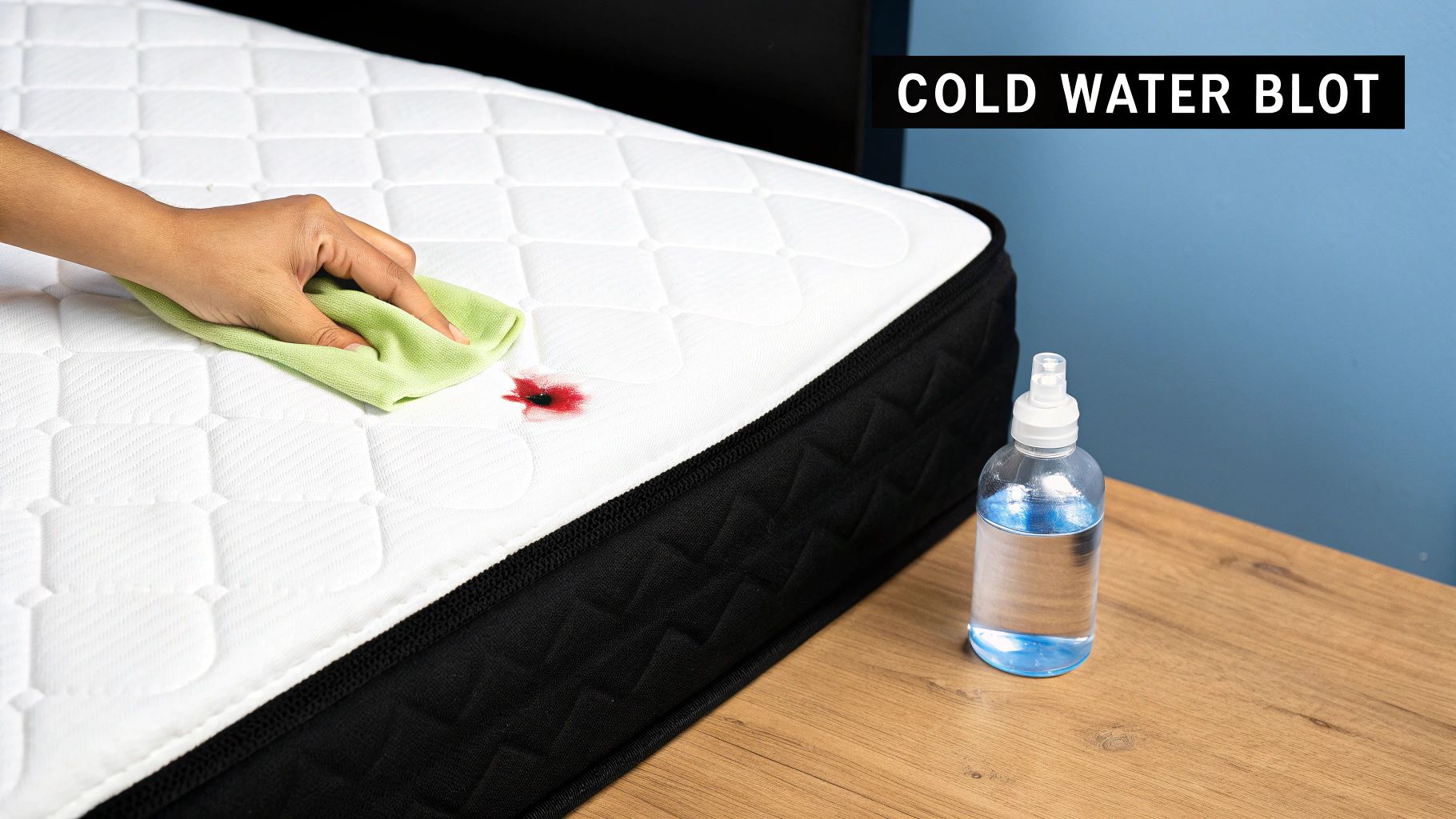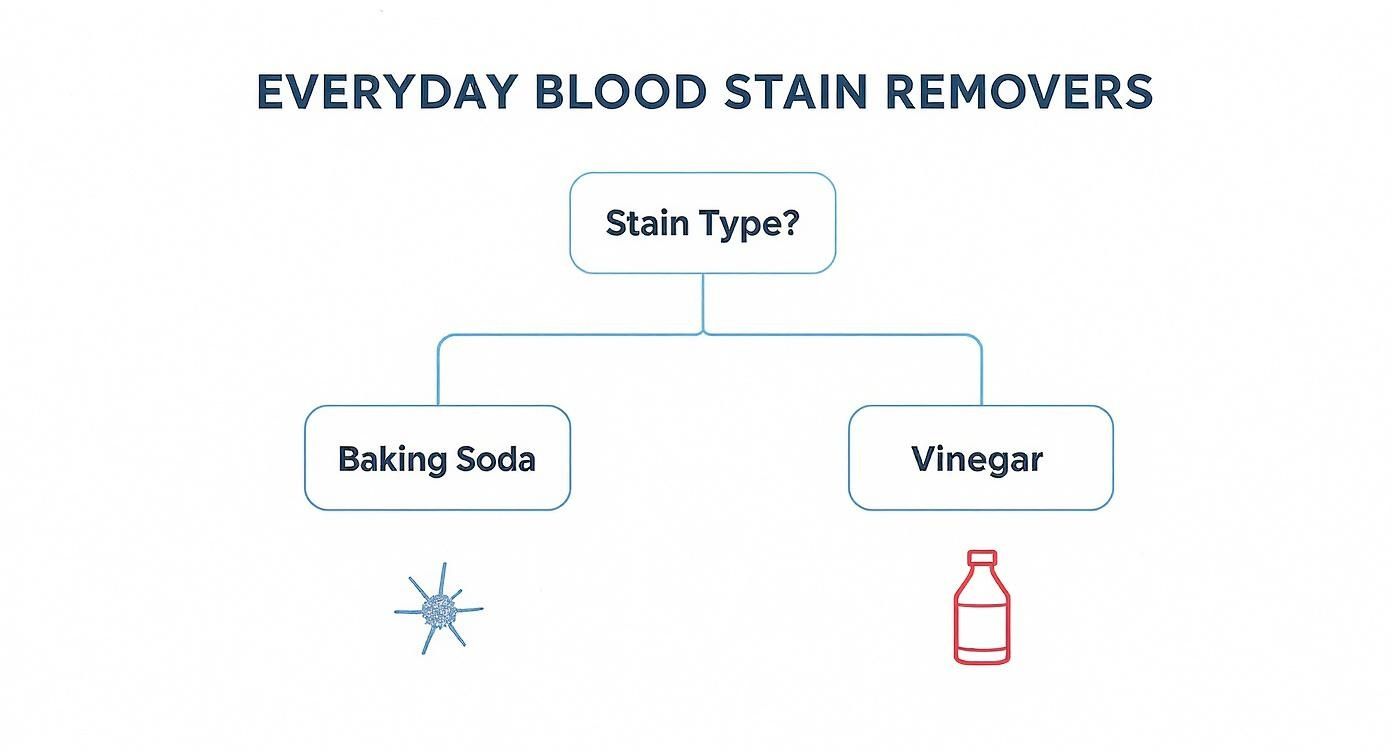Waking up to a blood stain on your mattress is never a great start to the day. But don't worry—that startling discovery doesn't have to mean a ruined bed. The most important thing is to act fast, and your best tool is probably already in your tap: cold water. Knowing how to get blood out of a mattress is a skill every household needs, and this guide will show you exactly what to do, step-by-step.
What to Do in the First 5 Minutes
That initial moment of spotting a blood stain is critical. A calm, quick response can prevent a small accident from becoming a permanent mark. Your goal isn't frantic scrubbing; it's smart damage control.

This immediate action is your best defence. You need to lift as much fresh blood as possible before it soaks into the mattress fibres and starts to dry.
1. Blot, Don't Rub
Before you do anything else, grab a clean, dry cloth or paper towel and gently blot the stain.
Key Tip: Always blot. Rubbing grinds the blood deeper into the fabric and spreads the stain, making it much harder to remove. Press down firmly, lift, and use a fresh section of the cloth to repeat until no more blood is absorbed.
2. Use Cold Water Only
Next, dampen a fresh cloth with cold water. Working from the outer edge of the stain toward the centre, continue blotting. This technique stops the stain from spreading outwards.
Never use hot water. Heat acts as a binding agent for the proteins in blood, effectively "cooking" the stain into the mattress fibres permanently.
3. Prepare for a Deeper Clean
These first steps contain the problem and remove the surface-level blood. For a tiny spot, this might be all you need. For larger stains, this prepares the area for one of the simple cleaning solutions below.
You're not alone in this—it's a common household accident. In fact, one study found that over 70% of people have dealt with body fluid stains on their mattress.
Here's a quick reference for those crucial first moments.
Quick Actions for Fresh Blood Stains
| Action | Why It Works | What to Avoid |
|---|---|---|
| Blot Immediately | Lifts excess liquid before it soaks in, preventing a deeper stain. | Rubbing or Scrubbing – this pushes the stain further into the fibres. |
| Use Cold Water | Helps to break down and dilute fresh blood without setting it. | Hot or Warm Water – this will 'cook' the proteins and set the stain permanently. |
| Work Outside-In | Prevents the stain from spreading and creating a larger discoloured area. | Starting in the Middle – this can cause the stain to bleed outwards. |
By handling the first few minutes correctly, you've already won half the battle. This not only sets you up for complete stain removal but also equips you to handle other common spills. For a wider look at keeping your bed pristine, our guide on how to clean bed stains has you covered.
How to Get Blood Out of a Mattress with Household Items
You don't need expensive, specialised cleaners. Some of the most effective solutions for getting blood out of a mattress are likely already in your kitchen.
Knowing how to use common items like baking soda, vinegar, or hydrogen peroxide means you can act immediately, which is key to success.
Baking Soda Paste for Fresh Stains
Baking soda is a gentle yet powerful cleaner. It works by drawing the stain and moisture up and out of the fabric as it dries.
- Create the Paste: Mix one part baking soda with two parts cold water in a small bowl.
- Apply: Spread the paste over the entire stain.
- Wait: Let it sit for at least 30 minutes, or until completely dry.
- Remove: Scrape or vacuum away the dried residue.
White Vinegar for Breaking Down Stains
The mild acetic acid in white vinegar is excellent for breaking down blood.
- Apply: Lightly dab a small amount of white vinegar onto the stain with a cloth.
- Let it Work: Leave it for about 10–15 minutes.
- Rinse: Gently blot the area with a fresh cloth dampened with cold water.
These same methods are often just as effective on your bedding. If you need more detailed advice for different fabrics, check out our guide on how to remove blood from sheets.
Hydrogen Peroxide for Tougher Spots
For a more stubborn fresh stain, 3% hydrogen peroxide is your go-to. It creates a fizzing reaction as the oxygen works to lift the stain from the fibres.
Safety First: Hydrogen peroxide can act as a mild bleach. Always test it on a small, hidden area of your mattress first (like an underside seam) to ensure it doesn't cause discolouration.
Once you've spot-tested, apply a small amount directly to the stain. Let it bubble for a few minutes, then blot it up with a clean cloth. Repeat if necessary.
Step-by-Step: Removing Fresh vs. Dried Blood Stains
The age of the stain determines your cleaning method. Fresh stains are much easier to tackle, while dried blood requires a stronger approach to break down the set-in proteins.
This infographic shows you which household item is best for the job.

As you can see, baking soda is your best first choice for fresh stains. For dried blood, you'll need something with more power, like an enzyme cleaner.
Tackling Old, Dried Blood Stains
Discovering an old blood stain can feel like a lost cause, but it isn't. You just need a solution that can break down the proteins that have bonded with the mattress fibres.
The challenge with an old stain is that the blood has oxidised and seeped deep into the fabric. This requires a more targeted treatment.
Your Best Weapon: Enzyme Cleaners
For set-in blood stains, an enzyme cleaner is your most effective tool. These products are specifically formulated to digest protein-based stains like blood or sweat, breaking them down on a molecular level.
Always follow the product's instructions. Typically, you'll spray the cleaner lightly onto the stain, let it sit for 15-20 minutes, then gently blot with a clean, damp cloth.
An Unlikely Hero: Meat Tenderiser Paste
It sounds strange, but unseasoned meat tenderiser is fantastic for dissolving dried blood. Enzymes like papain or bromelain break down the tough, set-in proteins.
- Make a Paste: Mix one tablespoon of meat tenderiser with two tablespoons of cold water.
- Apply: Spread the paste over the stain.
- Wait: Let it sit for up to an hour.
- Clean: Scrape off the dried paste and blot the area with a cold, damp cloth to rinse.
These advanced techniques may require a second application. For more tips on tough marks, this DIY guide for removing set-in carpet stains offers strategies that can be adapted for a mattress. And while you're at it, your bedding might need a refresh too. Our guide on how to wash doonas can help.
How to Dry and Protect Your Mattress After Cleaning
Congratulations, you've removed the stain! But your job isn't done. Properly drying the mattress is essential to prevent mould and mildew from forming.
This final step is about safeguarding your mattress for the long term. A completely dry mattress is a healthy one.
Ensure a Thorough Dry
Never put sheets back on a damp mattress. The key is to maximise air circulation to draw out every last bit of moisture.
- Use a Fan: Point a fan directly at the damp spot to speed up drying.
- Open Windows: Let in fresh air and sunlight. The sun's UV rays are a natural sanitiser.
- Try a Hairdryer (Cool Setting): Target the area with a hairdryer, but only use the cool setting. Heat can set any faint traces of the stain that might remain.
Prevention is the Best Cure
Once clean and dry, the best way to avoid future headaches is prevention. A high-quality waterproof mattress protector is your best defence.
A good mattress protector creates an impenetrable barrier against spills, sweat, dust mites, and allergens. It doesn't just prevent stains; it preserves the hygiene and lifespan of your mattress.
Think of it as insurance for your bed. Instead of scrubbing stains, you can simply remove the protector and put it in the wash. For ultimate comfort and peace of mind, explore the benefits of a bamboo waterproof mattress protector.
Common Questions About Removing Blood From a Mattress
Even with the best instructions, you might have a few questions. Here are answers to the most common queries.
Can I use soap and water?
It's best to avoid common hand or dish soaps. They often contain oils that can leave a residue, which attracts more dirt. If it's your only option, use a single drop of clear laundry detergent in a bowl of cold water. Be sure to "rinse" the area afterwards by blotting with a cloth dampened with fresh cold water to remove any soapy residue.
When should I call a professional?
For most minor blood stains, DIY methods work perfectly. However, if you're facing a very large or old stain that hasn't budged after a few attempts, it may be time to call in the experts. Professional cleaning services have specialised equipment and solutions that can often save a mattress you thought was a lost cause.
Why is there a yellow stain after cleaning?
A faint yellow ring around the cleaned area is a common frustration. It's usually a sign that too much liquid was used. As the water evaporates, it can pull minerals and residues from within the mattress foam to the surface.
The Golden Rule: Be sparing with moisture. Always dampen your cloth rather than pouring liquid directly onto the mattress, and blot thoroughly to dry.
If you have other questions about mattress care, you can find more helpful tips on our frequently asked questions page.
Ready for a worry-free sleep? Protect your mattress from future stains and spills with a premium waterproof protector from Sienna Living. Shop our collection today and enjoy the peace of mind that comes with superior protection and comfort.

